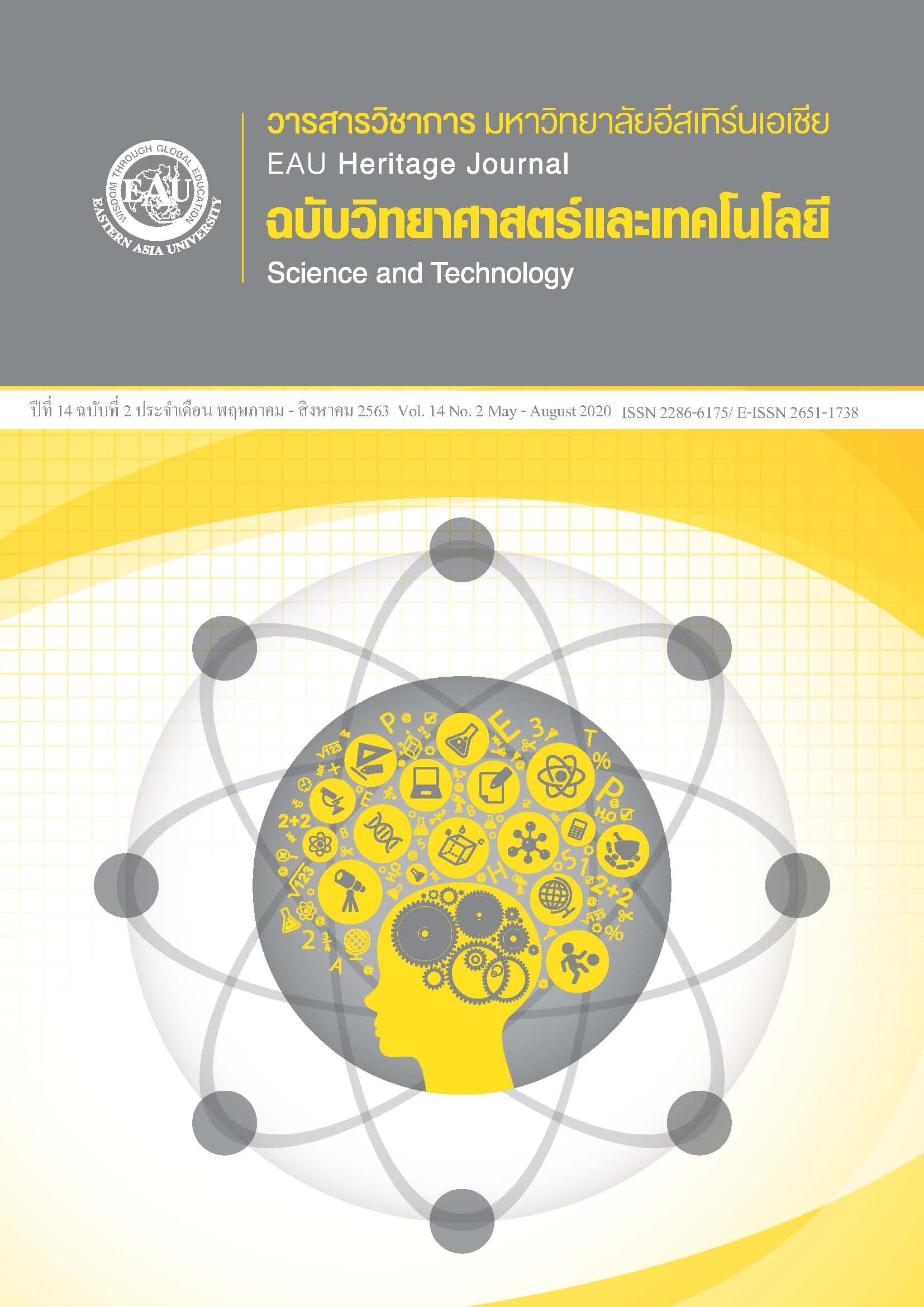การศึกษาการตั้งสูตรตำรับโทนเนอร์ที่มีฤทธิ์ต้านอนุมูลอิสระจากสารสกัดเปลือกต้นแก้วมังกร
คำสำคัญ:
แก้วมังกรเนื้อขาว, ฤทธิ์ต้านอนุมูลอิสระ, สารกลุ่มเบต้าเลน, สูตรตำรับโทนเนอร์บทคัดย่อ
การวิจัยครั้งนี้เป็นการวิจัยเชิงคุณภาพ มีวัตถุประสงค์เพื่อศึกษาการทดสอบเปรียบเทียบฤทธิ์ต้านอนุมูลอิสระของสารสกัดเอทานอลและการพัฒนาสูตรตำรับโทนเนอร์จากเปลือกแก้วมังกร โดยการสกัดเปลือกผลแก้วมังกรเนื้อขาวที่มีสารในกลุ่มเบต้าเลนโดยวิธีการหมักด้วย 70% และ 95% เอทานอล และวิเคราะห์หาปริมาณสารสำคัญจากสารสกัดหยาบ เพื่อเปรียบเทียบฤทธิ์ต้านอนุมูลอิสระโดยวิธีดีพีพีเอช ด้วยเครื่องยูวี-วิสิเบิล สเปกโทรโฟโตมิเตอร์ ที่ความยาวคลื่น 493 นาโนเมตร จากนั้นจึงนำไปพัฒนาเป็นสูตรตำรับโทนเนอร์และทดสอบความคงตัวด้วยวิธีการแช่แข็งและการละลาย จากผลการทดสอบพบว่าสารสกัดหยาบ 70% เอทานอล เท่ากับ 11.25% โดยน้ำหนัก ส่วนสารสกัดหยาบ 95% เอทานอล เท่ากับ 5.48% โดยน้ำหนัก ซึ่งพบว่า สารสกัดหยาบ 70% เอทานอลมีฤทธิ์ต้านอนุมูลอิสระมากกว่าสารสกัดหยาบ 95% เอทานอลที่ความเข้มข้นเดียวกัน และเมื่อนำมาพัฒนาต่อเป็นสูตรตำรับโทนเนอร์และทดสอบความคงตัวจะ พบว่า ปริมาณความเข้มข้นของสารสำคัญในตำรับก่อนทดสอบความคงตัวสูตรตำรับที่ 1, 2 และ 3 มีค่าเท่ากับ 0.63, 0.64 และ 0.63 มิลลิกรัมต่อมิลลิลิตร และหลังจากทดสอบความคงตัวจะมีค่าเฉลี่ยความคงตัวของสูตรตำรับที่ 1, 2 และ 3 มีค่าเท่ากับ 0.21, 0.52 และ 0.58 มิลลิกรัมต่อมิลลิลิตร ตามลำดับ ดังนั้นสูตรตำรับที่ 3 จึงมีความคงตัวสูงที่สุดและมีความเข้มข้นของสารสำคัญที่ละลายอยู่ใน 70% เอทานอล เท่ากับ 0.55 มิลลิกรัมต่อมิลลิลิตร
เอกสารอ้างอิง
American Academy of Dermatology. (2017). Melasma. Retrieved from https://www.aad.org.
Azeredo, H. M. C. D. (2009). Betalains: Properties, sources, applications, and stability–a review. International Journal of Food Science & Technology, 44(12), 2365-2376.
Castellar, M. R., ObÓn, J. M., & Fernández-LÓpez, J. A. (2006). The isolation and properties of a concentrated Red-Purple Betacyanin food colourant from Opuntia stricta fruits. Journal of the Science of Food and Agriculture, 86, 122-128.
Chaovanalikit, A., Techacheewapong, P., & Tungcharernkit, P. (2010). Stability of Betacyanin form Pitaya Peel. Agricultural Science Journal, 41(Suppl 3/1), 409-412. (in Thai)
Chinmueang, W., Kijkobchai, P., Suwannatee, H. & Suntornwa, O. (2008). Betalain from two species of dragon fruit (Hylocereus undatus and Hylocereus polyrhizus). Agricultural Science Journal, 39(Supplement 3), 182-186. (in Thai)
Choo, W. S. (2015). Betalains: Application in functional foods. Bioactive Molecules in Food (pp.1-28). Retrieved from https://link.springer.com/referenceworkentry/10.1007/978-3-319-54528-8_38-2
Elbandy, M. A., & Abdelfadeil, M. G. (2008). Stability of Betalain pigments from Red Beetroot (Beta vulgaris). Journal of Food Science, 36, 49–60.
Halliwell, B. (1991). Drug antioxidant effects. A basis for drug selection?. Drugs, 42(4), 569-605.
Harivaindaran, K. V, Rebecca, O. P. S., & Chandran, S. (2008). Study of optimal temperature, pH and stability of Dragon Fruit (Hylocereus polyrhizus) peel for use as potential natural colorant. Parkistan Journal of Biological Sciences, 11(18), 2259-2263.
Herbach, K. M., Stintzing, F. C., & Carle, R. (2006). Betalain stability and degradation structural and chromatic aspects. Journal of Food Science, 71(4), R41-R46.
Hudson, B. J. (1990). Food Antioxidants. Elsevier Applied Food Science Series (pp. 253-307). Retrieved from https://www.springer.com/gp/book/9789401068246.
Kosiyajinda, S. (2001). Dragon Fruit plant economic and fruit health. Department of Agriculture: Horticulture Research Institute, Horticulture Science Society of Thailand. Retrieved from http://puechkaset.com (in Thai)
Leelapornpisit, P. (2001). Cleansing Cosmetics (Revised Edition). Bangkok: Odian Store. (in Thai)
Moreno, D. A., Garcia-Viguera, C., Gil, J. I., & Gil-Izquierdo, A. (2008). Betalains in the era of global agri-food science, technology and nutritional health. Phytochemistry Reviews, 7(2), 261-280.
Nararatwanchai, T. (2016). Anti-aging. School of Anti-Aging and Regenerative Medicine, Mae Fah Luang University. Retrieved from http://anti-aging.mfu.ac.th (in Thai)
Nurliyana, R., Syed Zahir, I., Suleiman, M., Aisyah, M. R., & Rahim, K. (2010). Antioxidant study of Pulps and Peels of Dragon Fruits: A comparative study. International Food Research Journal, 17(2), 367-375.
O-Chongpian, P., Pimmpa, P. & Jantrawut, P. (2017). Development of Eyes Mask Containing Dragon Fruit peel extract. Journal of Agriculture, 33(3), 415-425. (in Thai)
Phasipol, T. (2014). Betalain: Extraction and Analysis. KKU Science Journal. 42(4), 718-729. Retrieved from http://scijournal.kku.ac.th/files/Vol_42_No_4_P_718-729.pdf (in Thai)
Priatni, S. & Pradita, A. (2015). Stability study of Betacyanin extract from Red Dragon Fruit (Hylocereus polyrhizus) peels. Procedia Chemistry, 16, 438-444.
Rujisawang, P., & Singpraseart, S. (2018). The development of Toner formulation with Anti-Oxidant activity from peels of Hylocereus undatus extract. (Doctoral dissertation). Eastern Asia University. Pathum Thani. (in Thai)
Stinzing, F. C., & Carle, R. (2004). Functional properties of Anthocyanins and Betalains in plants, food and in human nutrition. Trends in Food Science Technology, 15, 19-38.
Strack, D., Vogt, T. & Schliemann, W. (2003). Recent advances in Betalain research. Phytochemistry, 62(3), 247-269.
Thammawong, K. & Jaiwut, P. (2014). Development of Natural Colorant from Dragon Fruit Peel for cosmetic application, School of Cosmetic Science, Mae Fah Luang University. Retrieved from http://postgrads.mfu.ac.th (in Thai)
Teng-Umnuay, P. (2013). Anti-aging medicine (Master of Science Program in Anti-Aging and Regenerative Medicine). Dhurakij Pundit University, Bangkok. Retrieved from http://tlaa.org. (in Thai)
Tonglim, J., & Suttisansanee, U. (2016). Potential anti-aging from tea, Institute of Nutrition, Mahidol University. Retrieved from http://www.inmu.mahidol.ac.th (in Thai)
Wee, S. C., & Wee, K. Y. (2011). Antioxidant properties of two species of Hylocereus fruits. Advances in Applied Science Research, 2(3), 418-425.
Wessagowit, V. (2014). Wrinkle. Retrieved from http://inderm.go.th (in Thai)







